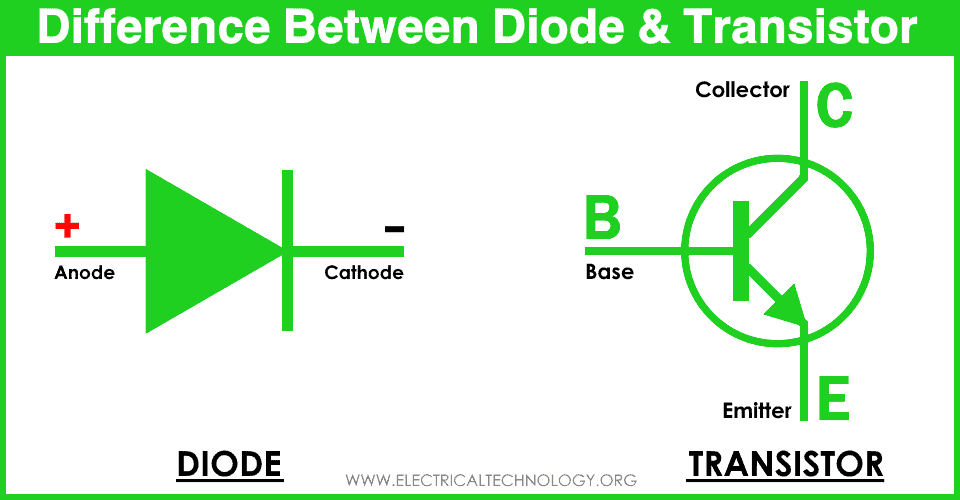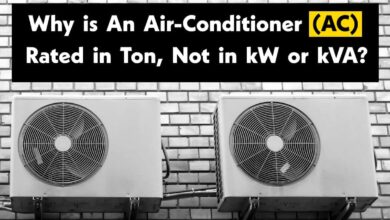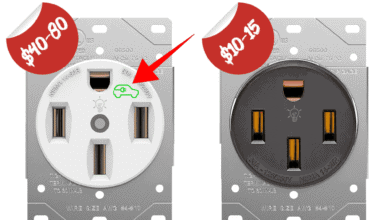Difference Between Diode and Transistor
What are the Key Differences Between Diode and Transistor?
Diode and transistor are semiconductor-based electronic switches mostly used in every electronic device. Apart from that, they are quite different in every other way.
Before going into the list of differences between diode and transistor, we are going to discuss their basics.
P-type and N-type semiconductor materials are used for the construction of diode and transistors. Semiconductor are available in an intrinsic (pure) form where the amount of positive (hole) and negative (electrons) charges are same. They are made into extrinsic form by adding impurities to increase their conductivity. When impurities are added to a semiconductor crystal, P-type and N-type semiconductor materials are formed.
When a semiconductor is doped with a dopant having 5 valence-electrons, an N-type material is formed. Such semiconductor has free electrons in their valence shell. These electrons are free to move and serve as a charge carrier. Due to the presence of a higher number of electrons, they are named majority carriers. While the holes are minority carriers.
By doping the semiconductor with a dopant having 3 valence-electrons forms P-type material. Such material can accept or catch electrons. Therefore, P-type materials have holes. Holes are the absence of electrons. Due to the majority of holes, they are majority charge carriers in P-type material and electrons are minority carriers.
A PN-junction is a boundary between P-type and N-type material. Providing proper biasing or voltage between these junctions shrinks or expands this region to allow or block the flow of charges between the two layers.
Related Post:
- Difference Between NPN and PNP Transistor
- What is The Difference Between Transistor and Thyristor (SCR)?
Diode
A diode is a semiconductor switch made from a combination of two layers of P-type and N-type material. There is only one PN junction in a diode having only two terminals i.e. Anode and Cathode.
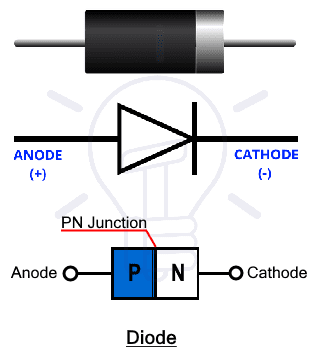
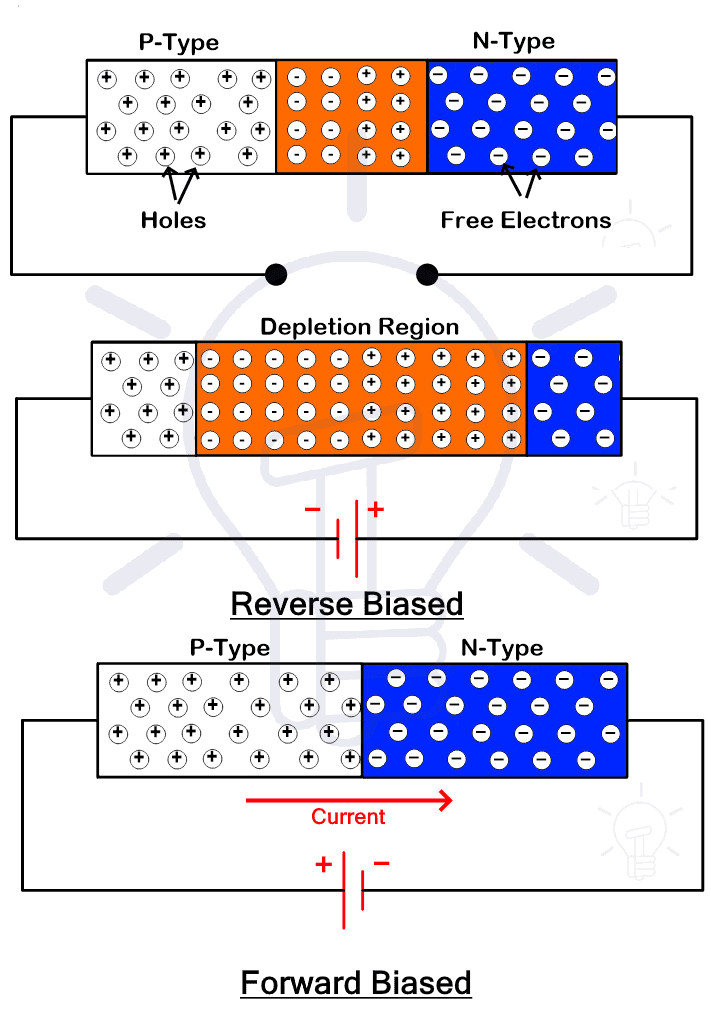
A diode has many different types and each type is used for its special purpose. Some of these types are. Light-emitting diode (LED), Photodiode, Zener diode, Avalanche diode, Laser Diode, PIN Diode, Varactor and Tunnel Diode.
A diode has a wide range of applications used in electronics. Some of these applications are rectification, Voltage clipping and Clamping, Circuit Protection, Voltage regulation and multiplication, light source, etc.
Related Posts:
- Difference Between DIAC and TRIAC
- Thyristor and Silicon Controlled Rectifier (SCR) – Thyristors Applications
Transistor
The transistor is a semiconductor device made from 3 alternating layers of P-type and N-type material. In other words, either P-type is sandwiched between two N-types or the other way around. Or you could say that a transistor is made from two diodes joined back to back. Thus transistor has two types based on its construction i.e. PNP Transistor and NPN Transistor. The type of the transistor depends on its construction and also affects the type of majority carriers in it.
The word transistor is a combination of two words “transfer” and “resistor” meaning “transfer of resistor”. Its operation is based on the transfer of resistance between its terminals (from one circuit to another) to allow or amplify the charges between them.
The following figure given below shows the structure and a symbolic representation of a transistor.
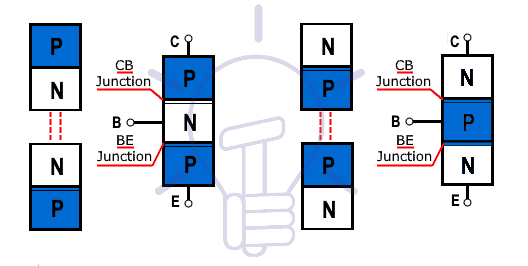

Therefore, a transistor has 3 regions of operation i.e. Active region, cutoff region and saturated region. The active region is used for amplification while the cutoff and saturated region is used for switching.
The transistor starts conduction when the Base-Emitter junction is in forward bias and the Collector-Base junction is in reverse bias. Therefore, it requires two voltage sources to operate.
The transistor is an active component and requires an extra power source to process the input signal. Whereas, the diode operates only on the input signal. However, the transistor can switch ON and OFF on command.
Greek root di, meaning “two”, and ode, a shortened form of “electrode.”
Related Posts:
- PNP Transistor? Construction, Working and Applications
- NPN Transistor? Construction, Working and Applications
Transistors are mainly used for magnifying or amplification of small signals, audio amplifiers, switches etc.
Main Differences Between Diode and Transistor
The following comparison table shows the main differences between a diode and a transistor.
| Diode | Transistor |
| A Semiconductor device that allows current flow in only one direction. | A semiconductor device is capable of switching and transfer voltage between low resistance circuit and high resistance circuit. |
| The diode is made of two layers of P-type and N-type semiconductor. | It is made of 3 layers of alternating semiconductor material (P-N-P and N-P-N). |
| It has two terminals called anode and cathode. | It has three terminals named emitter, base and collector. |
| The diode has many types such as LED, Photodiode, Zener diode, Tunnel, Varactor, etc. | Transistor has two major types Bipolar Junction (BJT) and Field Effect transistor (FET). |
| There is only 1 PN Junction. | There are 2 PN junctions i.e. Collector-Base and Base-Emitter junctions. |
| It is mainly used for rectification of AC into DC. | It is only used for switching and amplification. |
| It is a unidirectional switch. | It is a switch as well as an amplifier. |
| It performs uncontrolled Switching. | Transistor can perform controlled switching using the base signal. |
| A diode has only one depletion region. | Transistor has two depletion regions. |
| A diode is a passive component. | A transistor is an active component. |
| It only needs one voltage source to operate. | It needs two voltage sources to operate. |
| Diodes are used for multiples purposes such as rectification, clipping, clamping, protection, voltage multiplier, voltage regulator, etc. | It is used for switching and amplification. Best used in high-frequency applications. |
Related Posts:
- Difference Between Microprocessor and Microcontroller
- Difference Between 8085 and 8086 Microprocessor – Comparison
Properties and Characteristics of Diode & Transistor
The following different properties differentiate both Diode and a transistor having different characteristics and applications.
Construction
A diode is made from two layers of semiconductor. It is made from a combination of P-type and N-type material
The Transistor is made from three alternating layers of semiconductor. P-type material is sandwiched between N-type material to form an NPN transistor and N-type material is sandwiched between P-type material to form a PNP transistor.
Terminals
The diode has two terminals extended from P-region and N-region. The terminal connected with the P region is called Anode and while the terminal connected with N-region is called Cathode.
The transistor has 3 terminals. Each terminal is connected with each P or N region. The terminals connected with the outermost region are called collector and emitter while the terminal connected with the middle region is called the base.
The emitter region is heavily doped as compared to the collector region.
Related Posts:
- Difference Between CPU and GPU – Comparison
- Difference between Analog and Digital Circuit – Digital vs Analog
PN Junctions & Depletion Region
A diode is made from a combination of only two layers that is why there is only one PN junction as well as only one depletion region.
The transistor is constituted of 3 alternating layers. Therefore, there are 2 PN junctions as well as 2 depletion regions.
Switching
The diode can perform switching but it is in an uncontrolled manner. It means it cannot switch on or switch off on command.
On the contrary, the transistor operates according to the signal applied at its base terminal. it can switch on and switch off according to the base signal. Therefore, it provides full control over switching thus providing a controlled power supply.
Active and Passive Component
A diode is a passive component because its output solely depends on its input and it does not require any extra power supply.
A transistor is an active component because its output depends on the input signal as well as its biasing. It requires an extra supply for its biasing.
Applications
The application of diode is not limited to only switching as it has various different types having special uses. Generally, diodes are used for rectification, clipping, clamping, circuit protection, voltage regulation, voltage multiplication, Solar panels, LEDs, Voltage spike suppression, etc.
A transistor is a basic component of an electronic and logic circuit due to its high switching speed. Although it is also widely used for amplification and controlling of power supplied.
Related Posts:
- Difference between Electron Current and Conventional Current
- Difference Between RAM and ROM – Comparison
- Difference Between Synchronous and Asynchronous Transmission
- Difference between Inverter and UPS – Uninterruptible Power Supply
- Difference Between Online UPS and Offline UPS – Which One is Better?
- Diode Symbols – Electronic and Electrical Symbols
- Transistor, MOSFET and IGFET Symbols
- How to Check a Transistor by Multimeter (DMM+AVO) – NPN and PNP – 4 Ways
- How to Test a Diode using Digital and Analog Multimeter – 4 Ways.
